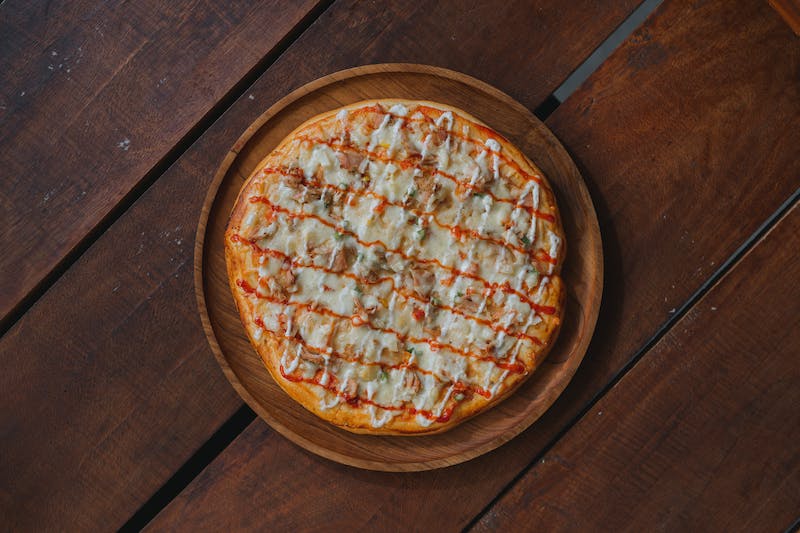In the realm of culinary delights, pizza holds a special place in our hearts and stomachs, effortlessly bridging the gap between gourmet dining and comfort food. Yet, amidst the joy of indulging in a slice (or three), a question lingers in the minds of pizza aficionados everywhere: “How long is pizza good for in the fridge?” This inquiry is not just about prolonging the lifespan of our beloved pie but also touches on the intricate dance between flavor preservation and food safety.
This article is designed not only to answer your pressing question with precision but also to arm you with knowledge that could revolutionize the way you store and enjoy leftovers. We’ll uncover the factors that affect pizza’s shelf life in the fridge, from the type of toppings to the way it’s boxed and the temperature at which it’s stored. But our journey doesn’t stop at mere days and numbers; we delve deeper to discuss how these factors influence the taste and texture of your pizza upon reheating, ensuring that your next slice is as delightful as when it first came out of the oven.
How Long Is Pizza Good For in the Fridge?
First, let’s set the record straight on how long pizza leftovers stay good:
- Pizza left at room temperature should be eaten within 2 hours.
- In the refrigerator, properly stored pizza lasts 3-4 days.
- Frozen pizza leftovers, if well wrapped, keep for 2-3 months.
The key is slowing down bacterial growth by chilling pizza as quickly as possible after baking. Leaving pizza to linger on the counter leads to fast food poisoning risk.
So what’s the best way to store that leftover pizza? The fridge or freezer are your only options for enjoying delicious pizza later. Let’s explore proper storage methods.
Choosing the Best Containers for Pizza Storage
Storing pizza comes down to two priorities – preventing sogginess and blocking contamination. Here are smart container options:
- The original pizza box works in a pinch. Just be sure to tightly seal the top with foil.
- For fridge storage, use airtight plastic containers to maintain freshness without drying out.
- Opt for freezer bags to prevent freezer burn by removing excess air.
- Parchment paper or foil wrapped tightly around pizza creates a protective barrier.
- Invest in handy silicone stretch lids that cling to bowls, plates and pans for easy sealing.
No matter which container you choose, ensure it’s food-safe and makes a tight seal. Never reuse containers that stored raw meats, fish or eggs. Avoid plastic bags not designed for food freezing.
Special Considerations for Topping-Heavy Pizzas
The sheer weight and moisture of some pizza toppings requires extra storage finesse. Here’s how to handle leftover slices with:
- Wet toppings – Place slices sauce-side up on a paper towel to absorb moisture before covering.
- Leafy greens – Remove spinach, arugula or basil before storing to prevent wilting. Add back before eating.
- Meats – Extra protein like sausage and pepperoni can turn rancid quickly. Limit fridge storage to 2 days.
When in doubt, store bare crust and replace toppings just before eating for best results. Now let’s explore the fridge vs. freezer for storing pizza.
Step-By-Step Guide to Refrigerating Leftover Pizza

Read on to learn more : How Big are Little Caesars Pizzas? Little Caesars Size Guide
For short term pizza storage, proper refrigeration preserves that just-baked taste. Follow these steps:
- Let pizza cool before boxing up – at least 10 minutes out of the oven. Hot pizza in an airtight box creates condensation.
- Place chilled slices in a shallow airtight container with parchment or wax paper between layers.
- For best results, store pizza cold side up to minimize moisture pooling under the warm crust.
- Refrigerate pizza right away, within 30 minutes baked. Leaving pizza at room temp invites bacterial growth.
- For longest shelf life, eat refrigerated pizza within 3-4 days. Mushy slices or an off smell means it’s time to toss it.
With the right chilled storage, you can enjoy delicious leftover pizza for days to come. Freezing extends storage even further.
Maximizing Shelf Life by Freezing Pizza
Freezing is the best solution for long term pizza storage and avoiding waste. Follow these steps:
- Allow baked pizza to cool completely before freezing – no warm slices.
- Place foil or parchment paper between slices to prevent frozen slices from sticking.
- For minimal air exposure, use freezer bags or airtight rigid containers. Remove excess air.
- Label bags or containers with pizza type and freeze date for easy identification.
- For best quality, eat frozen pizza within 2-3 months. Set a reminder to use older slices first.
- Thaw frozen pizza overnight in the fridge before reheating to prevent a soggy microwave mess.
With proper freezing techniques, you can keep leftover pizza tasting great for months to come. Now let’s conquer reheating.
Leftover Pizza
Foolproof Methods to Reheat Refrigerated Pizza
Bringing cold leftover pizza back to life takes a little skill. Here are pro tips for the best results:
- For thick or deep dish slices, use the oven or toaster oven at 300°F until hot, 5-10 minutes.
- For thin, Neapolitan-style pizza, use a hot skillet over medium-low heat to gently crisp the bottom.
- Microwave ovens work best for a quick reheat of 2-3 slices at 30 second intervals.
- Invest in a pizza stone to mimic a pizza oven for the crispiest reheated crust.
- Leftover pizza slices do great quickly browned in an air fryer at 375°F for 5-7 minutes.
- Stick to lower heat to melt cheese slowly without burning the crust or toppings.
Don’t settle for a chewy reheat – with the right technique, leftover pizza can taste nearly as scrumptious as the fresh-baked pie.
Innovative Tools for Reheating Pizza
Don’t limit yourself to boring old microwaves and ovens for reheating pizza. Consider these game-changing gadgets:
- Pizza Pouches – These reusable thermal bags reheat slices quickly in the microwave while preventing sogginess.
- Leftover Pizza Holders – These aluminum racks suspend pizza above a pan for crispy crusts.
- Pizza Crispers – These unique pans contain a perforated surface to mimic a pizza oven when reheating in your regular oven.
- Microwave Crisping Trays – The specially engineered surface of these trays gets pizza bottoms crispy, not soggy.
- Pizza Stones – Pre-heating this ceramic stone before use gives you an extra crispy crust.
Don’t settle for subpar slices – with the right tools, leftover pizza can be great pizza. Now let’s explore the nutritional aspects.
Changes in Nutritional Value After Reheating Pizza
Like most leftovers, nutritional values change somewhat upon reheating pizza. Here’s what happens:
- The calorie count stays the same, but…
- Vitamin C levels decrease by about 50% after initial baking. Reheating accelerates the vitamin loss.
- However, reheating does not significantly impact fat, protein, carb or mineral content.
- The starch molecules in the crust become more rapidly digestible after reheating.
- Overall, the nutritional differences are moderate. The benefits of avoiding food waste outweigh reheating’s effects on nutrition.
The bottom line – enjoy your leftovers guilt-free! Now let’s look at reheating tips for specialty diets.
Reheating Tips for Gluten-Free, Dairy-Free, and Vegan Leftover Pizza
Read on to learn more : How Big Is An 18 Inch Pizza? Get The Facts Here and Guides
Having food sensitivities doesn’t mean giving up enjoying leftover pizza. Use these reheating tips:
- Gluten-free crust – Use foil or a pizza stone to prevent sticking. Opt for oven or toaster oven reheating.
- Dairy-free cheese – Choose low heat to prevent burning non-dairy cheese. Add fresh after reheating.
- Vegan pizza – Keep an eye on veggie toppings which can overcook. Add fresh veggies like basil after reheating.
- Cauliflower crust – These low-carb crusts get soggy in the microwave. Use a skillet or oven for best texture.
- Nut-based cheese – To prevent burning, add nut-based shreds like cashew mozzarella after reheating pizza.
With the proper care, specialty leftover pizza can still be delicious. Now let’s look at determining pizza quality and safety.
How to Tell When Leftover Pizza Has Gone Bad
Like any food, pizza leftovers have a limited shelf life. Watch for these warning signs:
- An off or sour aroma indicates growing bacteria. Trust your nose!
- Mold growth – fuzzy dots or blooms mean pizza has oxidized and should be tossed.
- An overly soft or dried out crust. The texture suffers over time.
- Weeping oil or watery puddles forming around the pizza. This signals the ingredients have broken down.
- Changes in color like graying sausage or wilted looking veggies also indicates spoilage.
When in doubt, stick to the recommended 3-4 day maximum timeline for freshness. Now let’s look at delivered pizza.
Food Safety Tips for Handling Delivered Pizza

Takeout pizza needs some special handling for optimal safety and quality:
- Only order from reputable restaurants with good health ratings. Avoid sketchy pizza places.
- Opt for thicker, pan style pizzas for deliveries over 20 minutes. Thin crust gets soggy.
- Request the pizza is cut into wedges before delivery to retain heat better.
- Tip well to incentivize fast driving and keeping your pizza hot.
- Eat hot delivered pizza promptly, within 30 minutes of arrival. Don’t let it sit getting cold.
- Refrigerate leftovers ASAP, within 2 hours of getting your pizza order.
With some common sense precautions, you can safely enjoy delivered pizza. Now, let’s get creative with leftovers!
Innovative Recipes to Repurpose Leftover Pizza
Leftover pizza is endlessly versatile. Try it in these fun recipes:
- Blend into pizza hummus – perfect as a sandwich spread or veggie dip.
- Make pizza omelets or frittatas – great for weekend brunch.
- Transform into pizza paninis – just toast your slices in a panini press.
- Whip up a pizza pasta salad – dice up crusts and toppings then toss with dressing.
- Simmer into pizza soup – blend sauced crusts into a chunky, filling soup.
- Sprinkle bite-sized croutons over salads for a crunchy topping.
With creative thinking, leftover pizza becomes an exciting ingredient rather than boring leftovers.
Homemade Pizza Creations Using Leftovers
Leftover pizza components can also inspire completely new homemade pizza creations. Try these ideas:
- Make breakfast pizza – use crust as the base for eggs, bacon, sausage and cheese.
- Create BBQ chicken pizza – top crusts with bbq sauce, chicken and red onion.
- Build a taco pizza – turn crusts into personal pizzas topped with taco meat, cheese and lettuce.
- Invent your own signature pizza like a Thai chicken pizza with peanut sauce.
- Make dessert pizza – sprinkle leftover crust with cinnamon sugar, chocolate sauce or fruit.
Put those lonely crusts to good use as an instant pizza crust for round two. Have fun getting creative!

Chef John Sebastian has been cooking up a storm at his simple place for years. Offering a variety of international foods, Chef John Sebastian has something for everyone- and he makes it all look easy!
He’s been featured in various food magazines and cooking shows, and his restaurant has become a local favorite in the community. When he’s not in the kitchen, Chef John Sebastian enjoys spending time with his family.